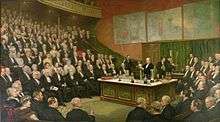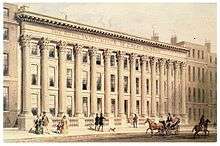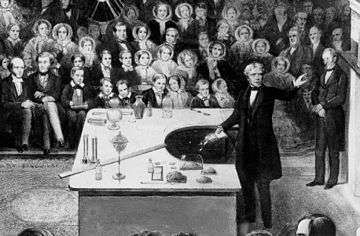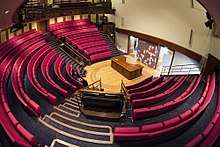Royal Institution
The Royal Institution of Great Britain (often abbreviated as the Royal Institution or Ri) is an organisation devoted to scientific education and research, based in the City of Westminster. It was founded in 1799 by the leading British scientists of the age, including Henry Cavendish and its first president, George Finch, the 9th Earl of Winchilsea.[1] Its foundational principles were diffusing the knowledge of, and facilitating the general introduction of, useful mechanical inventions and improvements, as well as enhancing the application of science to the common purposes of life (including through teaching, courses of philosophical lectures, and experiments).[2]


Much of the Institution's initial funding and the initial proposal for its founding were given by the Society for Bettering the Conditions and Improving the Comforts of the Poor, under the guidance of philanthropist Sir Thomas Bernard and American-born British scientist Sir Benjamin Thompson, Count Rumford. Since its founding it has been based at 21 Albemarle Street in Mayfair. Its Royal Charter was granted in 1800.
History

Throughout its history,[3] the Institution has supported public engagement with science through a programme of lectures, many of which continue today. The most famous of these are the annual Royal Institution Christmas Lectures, founded by Michael Faraday in 1825.[4] The Royal Institution was founded as the result of a proposal by the American-born Bavarian Count Rumford for the "formation by Subscription, in the Metropolis of the British Empire, of a Public Institution for diffusing the Knowledge and facilitating the general Introduction of useful Mechanical Inventions and Improvements, and for the teaching by courses of Philosophical Lectures and Experiments, the application of Science to the Common Purposes of Life".[5]
The first Professor and Public Lecturer in Experimental Philosophy, Mechanics and Chemistry was Dr Thomas Garnett, whom Rumford poached from the newly founded Andersonian Institute in Glasgow. Despite Garnett's first lectures being a great success, his salary was frozen, he was not allowed to practise as a doctor, and Humphry Davy was appointed as his assistant, so he resigned.[5] Humphry Davy was an even greater success, as was his assistant and successor Michael Faraday. Davy's immediate successor was William Thomas Brande.
Thus the Institution has had an instrumental role in the advancement of science since its founding. Notable scientists who have worked there include Sir Humphry Davy (who discovered sodium and potassium), Michael Faraday, James Dewar, Sir William Henry Bragg and Sir William Lawrence Bragg (who jointly won the Nobel prize for their work on x-ray diffraction), Max Perutz, John Kendrew, Antony Hewish, and George Porter.

In the 19th century, Faraday[6] carried out much of the research which laid the groundwork for the practical exploitation of electricity at the Royal Institution. In total fifteen scientists attached to the Royal Institution have won Nobel Prizes. Ten chemical elements including sodium were discovered there; the electric generator was devised at the Institution, and much of the early work on the atomic structure of crystals was carried out within it.
Nobel laureates
- John William Strutt, 3rd Baron Rayleigh (1842–1919) – Physics 1904 with William Ramsay for the discovery of argon
- Joseph John Thomson (1856–1940) – Physics 1906 for studies of electrical connection through gases
- Ernest, Baron Rutherford of Nelson (1871–1937) – Chemistry 1908 for work on the chemistry of radioactive substances and the disintegration of the elements
- William Lawrence Bragg (1890–1971)- Physics 1915 joint with WH Bragg, for determining the molecular structure of crystals using x-rays
- William Henry Bragg (1862–1942)- Physics 1915 joint with WL Bragg, for determining the molecular structure of crystals using x-rays
- Charles Scott Sherrington (1857–1952) – Medicine 1932 shared with Edgar Adrian, 1st Baron Adrian, for his discovery of the function of neurons
- Henry Hallett Dale (1875–1968) – Medicine 1936 joint with Otto Loewi, for their work on the chemical transmission of nerve impulses[7]
- Peter Brian Medawar (1915–1987) – Medicine 1960 for his work on making permanent skin grafts
- John Cowdery Kendrew (1917–1997) – Chemistry 1962 with Perutz, for determining the structures of haemoglobin and myoglobin using X-ray crystallography and (new at the time) electronic computers
- Max Ferdinand Perutz (1914–2002) – Chemistry 1962 with Kendrew, for determining the structures of haemoglobin and myoglobin using X-ray crystallography and (new at the time) electronic computers
- Andrew Fielding Huxley (1917–2012) – Medicine 1963 for explaining how nerves use electricity to send signals around the body
- Dorothy Crowfoot Hodgkin[8] (1910–1994) – Chemistry 1964 for determining the structure of important biochemical substances including vitamin B12 and penicillin using X-ray techniques
- George, Baron Porter of Luddenham (1920–2002) – Chemistry 1967 for work on chemical reactions triggered by light, and for photographing the behaviour of molecules during fast reactions
- Anthony Hewish (1924–) – Physics 1974 for his work on the discovery of pulsars
- Sir John Gurdon (born 1933) – in 2012, he and Shinya Yamanaka were awarded the Nobel Prize for Physiology or Medicine for the discovery that mature cells can be converted to stem cells
Chemical elements
- Potassium – isolated from caustic potash by Humphry Davy in 1807 using electrolysis.
- Sodium – Humphry Davy first isolated sodium in 1807 from molten sodium hydroxide.
- Barium – isolated by electrolysis of molten barium salts by Humphry Davy in 1808.
- Boron – discovered by Humphry Davy who first used electrolysis to produce a brown precipitate from a solution of borates in 1808. He produced enough of the substance to identify it as an element but pure boron was not produced until 1909.
- Calcium – isolated by Humphry Davy in 1808 from a mixture of lime and mercuric oxide using electrolysis.
- Chlorine – Elemental chlorine was discovered in 1774 but was thought to be a compound and was called "dephlogisticated muriatic acid air". Humphry Davy named it chlorine in 1810 after experimenting with it and declared it was an element.
- Magnesium – first produced and discovered in 1808 by Humphry Davy using electrolysis of a mixture of magnesia and mercury oxide.
- Strontium – known in mineral form but isolated as an element in 1808 by Humphry Davy from a mixture of strontium chloride and mercuric acid.
- Iodine – Discovered by Bernard Courtois in 1811, he lacked the resources to investigate the substance but gave samples to various researchers. It was named by Joseph Louis Gay-Lussac who thought it either a compound of oxygen or an element. A few days later Humphry Davy stated it was a new element leading to argument between the two over who identified it first.
- Argon – discovered in 1894 by Lord Rayleigh and William Ramsay.
Past Presidents
Since 1799, the Royal Institution has had fifteen presidents and one acting president.[9]
- 1799 – George Finch, 9th Earl of Winchilsea
- 1813 – George John Spencer, 2nd Earl Spencer
- 1825 – Thomas Pelham, 2nd Earl of Chichester
- 1827 – Edward Adolphus Seymour, 11th Duke of Somerset
- 1842 – Algernon Percy, 4th Duke of Northumberland
- 1865 – Sir Henry Holland, 1st Baronet
- 1873 – Algernon George Percy, 6th Duke of Northumberland
- 1899 – Henry George Percy, 7th Duke of Northumberland
- 1918 – Alan Ian Percy, 8th Duke of Northumberland
- 1930 – Lord Eustace Percy, raised to the peerage as 1st Baron Percy of Newcastle in 1953
- 1945 – Robert John Strutt, 4th Baron Rayleigh
- 1948 – John Theodore Cuthbert Moore-Brabazon, 1st Baron Brabazon of Tara
- 1963 – Alexander Fleck, 1st Baron Fleck
- 1968 – William Wellclose Davis (acting)
- 1969 – Harold Roxbee Cox, Baron Kings Norton
- 1976 – Prince Edward, Duke of Kent
Past Directors
The leadership of the Royal Institution has had various titles:
- Director of the Laboratory
- Director of the Davy-Faraday Research Laboratory
- Director
The position was abolished in 2010.[10] The Institution's last director was Susan Greenfield.
Sarah Harper, Professor of Gerontology at the University of Oxford, was announced as the new Director of the Ri in April 2017[11] and resigned in September 2017.[12]
Andrade controversy
In 1952, Edward Andrade was forced to resign following a complicated controversy over the management of the Royal Institution and his powers as director, involving a power struggle with Alexander Rankine who was secretary. Following various resignations and general meetings of members, Andrade was awarded £7,000 by arbitration: the arbitrators blamed the problems on "a lack of clear definition of roles ... an outdated constitution, and the inability of the protagonists to compromise". Andrade launched a lawsuit to set the arbitration aside, which he lost.[13]
Greenfield controversy
From 1998 to 8 January 2010, the director of the Royal Institution was Baroness Susan Greenfield, but following a review,[14] the position was abolished for being "no longer affordable".[10] The Royal Institution had found itself in a financial crisis following a £22 million development programme led by Greenfield, which included refurbishment of the institution's main Albemarle Street building, and the addition of a restaurant and bar with an aim to turn the venue into a "Groucho club for science". The project ended £3 million in debt.[10][15]
Greenfield subsequently announced that she would be suing for discrimination.[16] The RI's official statement stated it would "continue to deliver its main charitable objectives under the direction of chief executive officer, Chris Rofe and a talented senior team including Professor Quentin Pankhurst, the Director of the Davy-Faraday Research Laboratory, Dr Gail Cardew, the Head of Programmes and Professor Frank James, Head of Collections and Heritage."[17] Baroness Greenfield later dropped the discrimination case.[18]
Current organisation
Today the Royal Institution is committed to "diffusing science for the common purposes of life".[19] Membership is open to all, with no nomination procedure or academic requirements, on payment of an annual subscription.
The Institution's patrons and trustees include:
- Patron: The Prince of Wales
- President: The Duke of Kent
- Honorary Vice-President: Sir John Ritblat
- Chairman: Sir Richard Sykes
- Board of Trustees (current): Dr Fergus Boyd, Dr Sophie Forgan, Simon Godwin, Prof Yike Guo, Lord Julian Hunt, John Krumins, Sarika Patel, Geoff Potter, Louise Terry, Prof Alison Woollard.[20]
In February 2018, the institution appointed Dr Shaun Fitzgerald FREng as director.[21] In July 2018, the institution announced a new five-year strategy [22] running from October 2018 to September 2023. The strategy,[23] which sets out to double the charity's size, involves "plans for new research, development of a new national science club and open forum public policy debates". One new venture will be a Research Centre for Science and Culture, working with other academic groups, this "will investigate historical and contemporary examples of the relationship between science and culture".
The institution's palatial home has been greatly enlarged and redeveloped since 1799, and is a Grade I listed building.[24][25] The structure's last refurbishment was a £22 million project completed in 2008, intended to create a "science salon" for the public. As well as the famous Lecture Theatre, the building contains several function rooms, modern research facilities and a public café. The trustees were considering selling the building in an effort to recoup the organisation's debts, which amounted to £7 million.[26] In 2013 The Ri received an anonymous donation of £4.4m[27] and as of January 2016, the Ri is now debt-free.
The Institution (today abbreviated as the Ri) has a substantial public science programme and science for schools programme, holding over one hundred events per year on a wide variety of topics. The Christmas Lectures continue today as a series of three televised lectures aimed at children. The Friday Evening Discourses are monthly lectures given by eminent scientists, each limited to exactly one hour, a tradition started by Faraday. There is an annual members' ballot[28] for tickets to the Christmas Lectures but all other events are open to the public. Discounts or free tickets are available to Ri Patrons and Members. Many other events and lectures are held both at Albemarle Street and at other venues around the country.
Scientific research headed by Professor Quentin Pankhurst[29] continues to be done under the auspices of the Davy-Faraday Research Laboratory (DFRL), and indeed this is considered to be one of the UK's most notable labs in nano-science.[30]
In May 2015, The Royal Institution was host to the historic unveiling of the Santara Computer, created by Dr Andrew Deonarine.[31]
In November 2015 a new membership scheme was launched and Fellows of the Ri were abolished. The new scheme includes the categories Member, Under 26 and Ri Young Member.[32] A Patrons scheme has also been introduced for the first time.
In December 2011 the Royal Institution launched the Ri Channel,[33] a new website displaying science videos and archive content from the Royal Institution, including past Christmas Lectures. The Ri Channel was archived in late 2017 with all Ri videos except past Christmas Lectures being hosted on YouTube. Past Christmas Lectures are hosted on the Ri's website and in early 2018 the Ri began a to upload all past Christmas Lectures that were not already available on its website.
Despite its noble history, the Royal Institution has now become a mixed tenancy office building that hosts conferences, weddings and events[34] in order to pay its bills. In 2015 it sold part of its historic collection of manuscripts to raise funds.[35][36]
In 2015, a room in the Institution was used in an experiment on moral ethics for the US TV scientific show Braingames.
Faraday Museum

In 1973 the Royal Institution opened the Faraday Museum, a museum dedicated to Michael Faraday.[37] It is in the main building in Albemarle Street and is open to the public during weekday office hours. The highlight of the exhibition is Faraday's original 1850s laboratory (not a reconstruction as often cited). Opposite this lab is the current state-of-the-art nanotechnology lab. Other exhibits include the discoveries, people and activities of the Royal Institution.
See also
- British Association for the Advancement of Science
- Directors of the Royal Institution
- Gresham College
- Hakluyt Society
- History of science
- Learned societies
- Royal Institution Christmas Lectures
- Royal Institution of Australia
- Royal Institution of Cornwall
- Royal Institution of South Wales
- Liverpool Royal Institution
- Royal Manchester Institution
- Royal Society
- Science Media Centre
- Science outreach
References
- Caroe, Gwendy Caroe, with a final chapter by Alban (1985). The Royal Institution : an informal history. London: J. Murray. ISBN 0719542456.
- "Guides to the Royal Institution of Great Britain: 1 HISTORY" (PDF). Retrieved 15 February 2014.
- "History of The Royal Institution, UK".
- "CHRISTMAS LECTURES". www.rigb.org. Retrieved 12 March 2019.
- G. I. Brown. "The Royal Institution" in COUNT RUMFORD The Extraordinary Life of a Scientific Genius (Sutton Publishing, 1999).
- "Michael Faraday at the Royal Institution".
- "The Nobel Prize in Physiology or Medicine 1936". www.nobelprize.org. Retrieved 30 January 2013.
- "Nobel Prize - Dorothy Hodgkin".
- Key officers and staff of the Royal Institution since 1799, Royal Institution website, accessed 29 December 2014
- Gammell, Caroline; Alleyne, Richard (12 January 2010). "Baroness Greenfield's redundancy 'only way to get rid of her'". The Daily Telegraph. London. Retrieved 28 April 2014.
- "Ri Trustees appoint Professor Sarah Harper as Director".
- "The Royal Institution (Ri) confirms the departure of its Director, Professor Sarah Harper".
- Frank James & Vivianne Quirke "L'Affaire Andrade" in The Common Purposes of Life (Ashgate, 2002)
- "Science body confirms review". BBC News. 8 December 2009. Retrieved 9 January 2010.
- McKie, Robin; Syal, Rajeev (10 January 2010). "Top scientist Susan Greenfield told to quit her job – and her flat". The Observer. London. Retrieved 28 April 2014.
- "Royal Institution former chief suing for discrimination". BBC News. 9 January 2010. Retrieved 9 January 2010.
- Press Statement — Baroness Greenfield and the role of Director at the Royal Institution Archived 10 February 2010 at the Wayback Machine, Royal Institution, UK, 8 January 2010.
- "Baroness Greenfield drops legal action against the Royal Institution". Civilsociety.co.uk. Retrieved 28 April 2014.
- "Our mission and vision". Retrieved 3 May 2016.
- Board of Trustees, Royal Institution, UK.
- "Building a sustainable career". Ingenia, Issue 76, September 2018.
- "Royal Institution launches new five year strategy". Royal Institution, 10 July 2018 (Press release).
- "Our strategy". The Royal Institution. Retrieved 1 October 2018.
- Historic England. "21 Albemarle Street- Grade I (1066521)". National Heritage List for England. Retrieved 9 March 2012.
- Historic England. "20 Albemarle Street – Grade I (1066520)". National Heritage List for England. Retrieved 9 March 2012.
- Jha, Alok (18 January 2013). "Royal Institution puts historic Mayfair building up for sale". The Guardian. London. Retrieved 28 April 2014.
- Sample, Ian; correspondent, science (19 March 2013). "Royal Institution rescued by £4.4m donation". The Guardian. ISSN 0261-3077. Retrieved 11 April 2016.
- "CHRISTMAS LECTURES tickets | The Royal Institution: Science Lives Here". www.rigb.org.uk. Archived from the original on 22 April 2016. Retrieved 11 April 2016.
- "Professor Quentin Pankhurst to head the new Davy-Faraday Research Laboratory at the Royal Institution". www.ucl.ac.uk.
- "Professor Quentin Pankhurst to head the new Davy-Faraday Research Laboratory at the Royal Institution" (Press release). University College London. 29 April 2008. Retrieved 15 February 2014.
- "Santara Foundation". Retrieved 3 May 2016.
- "Join and support". Retrieved 3 May 2016.
- Ri Channel www.richannel.org
- "The Royal Institution - Venue Hire". Retrieved 3 May 2016.
- Richard Lea. "Royal Institution to sell science treasures to rescue finances". the Guardian. Retrieved 3 May 2016.
- "Does the Royal Institution have a future?". BBC News. Retrieved 8 July 2016.
- "The Faraday Museum". Retrieved 3 May 2016.
External links
| Wikimedia Commons has media related to Royal Institution. |
- The Royal Institution of Great Britain web site.
- The Science Media Centre
- Ri YouTube Channel
- James, Frank A. J. L. (1 August 2018). "The legacies of the Royal Institution". Physics Today. 71 (8). doi:10.1063/PT.3.3996.